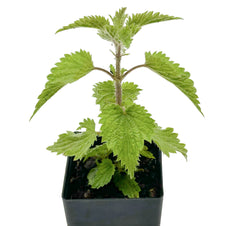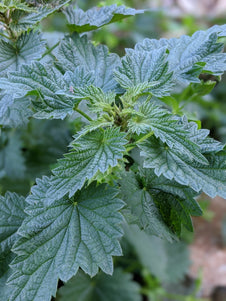







Nettle
Nettle
- In stock, ready to ship
- Inventory on the way

Usually available: All year
Life cycle: Herbaceous Perennial
Height: 50cm - 1.2m
Position: Sun / part shade
Soil preference: Well drained
This is how we pack and send your Herb Plants to all states except TAS & WA
You will receive
- 1 Nettle Herb Plant in a 50 X 75mm tube - General growing instructions
All of our Herb Plants are grown organically with certified organic potting mixes and fertilizers
Botanical Name: Urtica dioica
Also referred to as stinging nettle, burn nettle, common nettle or nettle leaf. Nettle is a medium growing herbaceous perennial reaching 1.2 meters high and up to 1 meter wide. The common British Stinging Nettle is known for the tiny stinging hairs which cause irritation to the skin upon contact. The leaves and stems have many tiny hairs called trichomes that inject histamine and other chemicals into the skin when the plant is touched by humans or animals. The leaves are a soft green and held in opposite pairs along the wiry, erect stem. The serrated leaves are long, ranging from 3-15cm and have a broad cordate base ending in a fine point. The flowers are a small greenish-brown colour.
The Nettle family consists of around 500 species with the genus Urtica encompassing the stinging nettles and the genus Parietaria covering the pellitory nettles. Urtica dioica, or Common Nettle, is distributed throughout the temperate regions of Europe and Asia, and is found in Japan, South Africa, Australia and The Andes. Some stinging nettles, particularly one from Java, can produce stings and chemical burns lasting a whole year and others may even cause death. There are several subspecies of Urtica diocia, with most having the stinging hairs.
Many insects find nettle beneficial, including many moths and butterflies that use it as a food plant in the larval stage. The presence of nettle seems to assist other plants in the garden, such as fruiting plants and trees.
Growing Conditions
Nettle is considered a weed by many people because it does grow well in rich soil and can easily colonise fertile areas, like cow paddocks. It has quite a fast growth rate and if nettle takes hold in an area it is generally a good indication of good soil. However, nettle will grow in a sandy, loam or clay soils and tolerate low nutrient levels. A range of pH levels is okay, as long as the soil is not too acidic. Moist soil is preferred and it is not required to be well drained, so a damp spot in clay soil could be suitable. Waste areas, woodland edges, road sides and neglected spaces are often sites that nettle is found. Full sun, dappled shade or semi-shade is acceptable.
Nettle may be propagated by seed in spring or by division during the growing season. The seed is naturally wind propagated. The flowers are dioecious, so to have fertile seed, plants of both genders will be required. The flowers bloom from late spring, over summer and into early autumn. In areas with cold winters the plant will die down and return in spring.
Medicinal Uses
Stinging Nettle has a long history of traditional medicinal use in Europe. In Ancient Greece stinging nettle was mostly used as a laxative and a diuretic. Today nettle is used in Germany to treat arthritis and it was also used in traditional Austrian medicine for similar purposes. It is said to be useful for treating the urinary tract problems associated with an enlarged prostrate. There is some evidence to suggest that nettle may be useful when used under certain conditions to treat these ailments. However, further research is required for significant results.
All parts of the nettle plant can be used for different applications. The roots were used traditionally for treating urinary and prostrate related conditions, joint ailments, as a diuretic and an astringent. The parts of the plant above ground were used for UTI, kidney stones, allergies, hayfever, osteoarthritis, anaemia, poor circulation, diabetes and many other conditions. Nettle may be applied to the skin as a poultice to help muscle aches, oily scalp or hair and can be included in shampoos to help dandruff.
Culinary Uses
Traditionally Native Americans used to harvest young nettle plants to use as a vegetable when other plants were scarce. Today, nettle is becoming popular in the kitchen, with many recipes being shared in television cooking programs. It may be used in soups, pesto, polenta, and even as a puree. Nettle is higher in iron than spinach, contains vitamins A and C, and may be used as a vital ingredient in ‘green smoothies’. It is said to have a flavour similar to spinach and cucumber when cooked, with nutty overtones. The stinging effect of the leaves is neutralised by heat or by drying the leaves. However, it is important to use only the young leaves. The older leaves have a tendency to develop cystoliths, or tiny gritty calcium carbonate particles, which can irritate and damage the kidneys.
Other Uses
Nettles have good commercial and economic value that may not be realised by home gardeners. A permanent green dye is obtained from the leaves and stems, while a yellow dye is made from the roots when they are boiled with alum. The fibre is a strong and flax like substance obtained from the stems which are harvested as the plant begins to die down. The fibre may be used to make cloth, paper and rope.
All information provided on this website is for informational purposes only. Please seek professional advice before commencing any treatment.





